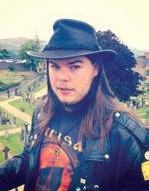The Big Question
This month’s question is: ‘Who is your favourite saint and why?’
Would you like to take part in a future Big Question?
Send us your details and interests to magazine@lifeandwork.org or write to us at Life and Work, 121 George Street, Edinburgh, EH2 4YN.

Iain Whyte, General Secretary, the Church of Scotland Guild

The Rev Mike Robertson, minister at Culloden: The Barn
“As a Scot, I am inevitably drawn to Saint Andrew as my favourite saint!
“There are, however, more reasons for my choice.
“Firstly, I like that St Rule apparently dreamt he had to take the relics of Andrew to the ‘ends of the earth’, resulting in him travelling to Scotland, which he presumably felt was the end of the earth. That idea gives a mix of significance and selfdeprecation, a sense of struggle and fortitude that we embody so willingly.
“Secondly, Andrew was a disciple noted for being present at many of the pivotal moments of Christ’s ministry…one of the first to be called, gathering the loaves and fishes, present at the Last Supper and so on. To have as ‘our’ Saint, someone so closely linked to Jesus is enthralling.
“Thirdly, Andrew was known as a strong, fair, generous and caring man… qualities that we would regard as typically Scottish, at least as characteristics to which we aspire.
“Fourthly, there is something in him being the younger brother of Peter, yet finding his own place to shine rather than live in a perceived shadow.
“This last reason points me in another direction….
“Clearly there is value in having iconic figures who illustrate our faith and our history, but my real choice would be ‘for all the saints who from their labours rest’… the unsung heroes and heroines who have lived by faith and laid the foundations on which we build, on whose shoulders we stand.
“‘Saint’ doesn’t sit well with many people when we think of ourselves or others around us, but becomes more palatable when talking about ‘Celebrities’ of the faith down the ages or local church heroes!
“Yet, in scripture, ‘saints’ refers to the many not the few. Some translations use ‘His people’.
“The purpose of Christ appointing Apostles, Prophets, Evangelists, Pastors and Teachers is to equip ‘His people’ or ‘the saints’ – Eph 4:11-16 (NIV, RSV).
“Amongst saints we all know, I’m most drawn to Peter.
“Not for his spectacular achievements, but because of his spectacular ordinariness or what would be considered in most circles as spectacular failures.
“There are many, but the most notable being his fear-filled denial of Jesus. Despite all his faults, Jesus chose Him anyway, forgave him multiple times and restored him because he, just like us, is a child of God, a saint.
“Amongst many unsung saints in my life, my wife, Laura is No 1.
“Sounds cheesy perhaps, but true!
“She knows my weaknesses, faults, all the less-than Christlike parts of me and yet, she’s my strongest supporter and encourager. Especially during a very difficult year, Laura has fought past battles of her own to pick me up and help remind me of where my true identity is found… in Jesus, not in failure or ill health! Christ’s light shines through her. That’s what good spouses do, but she is the one God blessed me with.
“She is a child of God, a saint.”

The Rev Alistair Dunlop, retired, Glassary, Kilmartin and Ford
“Elaine and I were born in Glasgow where St Mungo (St Kentigern) is fondly remembered.
“Licensed in Glasgow Cathedral, I then became Assistant Minister at Dunblane Cathedral. St Blane probably sought refuge there from the Viking raids on Bute.
“My ordination and induction was at Kirriemuir: St Ninian’s. St Ninian, best known for his work in Dunfries and Galloway also managed to reach Angus.
“Beith High my next charge is close to St Inan’s Chair, a cleft in a rock where Inan sat and preached while on a journey from Irvine to Paisley.
“My church in Kirriemuir began as a congregation of the Original Secession Church founded in Irvine in 1733. A coincidence, nothing more!
“From Beith I moved to Saddell and Carradale. The Cistercian Abbey at Saddell is now a ruin but the medieval carved gravestones are worth a visit. No saintly connection recorded but St Columba was all over Argyll from Southend to Iona. I must mention St Brendan’s church Skipness, a place of true Christian fellowship, dedicated to Brendan the Navigator.
“The saints I met on my journey were dedicated, good men but who is my favourite Saint of all time? I don’t have one. The New Testament describes all believers as saints. Singling out individuals, men or women, came later.
“For me, one song says it all: ‘Ah wanna be in that number, when the Saints go marching in’.”

Duncan Sneddon, member, Edinburgh: Greyfriars
“It used to feel funny, as a Protestant, to be asked about my ‘favourite saint’, but as a medieval ecclesiastical historian you quickly get used to it.
“Adomnán of Iona (c 620 – 704), whose
“Life of Saint Columba” is the focus of my PhD research, is my stock answer.
“As Gilbert Márkus has put it, he is in a sense the only ‘real’ person in the first 900-odd years of Scottish history, the only person to be more than a name, a few dates and some vague biographical details or accumulated legends.
“This is partially due to his writings: ‘The Life of Saint Columba’ and ‘On the Holy Places’ (a gazetteer of the Holy Land) reveal a powerful intellectual at work, with an eye for detail, a command of intricate literary structures and a fascination with language.
“He also cared deeply for the vulnerable: he arranged the release of captives taken in a Northumbrian attack on Ireland; his ‘Life of Columba’ is replete with accounts of Columba providing for and defending the poor (and bringing vengeance on their persecutors); he also wrote a law, ‘The Law of the Innocents’, protecting women, children and clerics from violence.
“This law was guaranteed by the Pictish and Dál Riatan kings, as well as many Irish kings and ecclesiastics – a striking early example of the church taking the lead in attempting to protect those who suffer most from the violence of the powerful.
“It is a legacy worth remembering.”

Anna Reid, member, Edinburgh: Stockbridge
“St Christopher the patron saint of travel and travellers is my favourite.
“I have made many special journeys to Greece and this year was no exception.
“However, when my feet touched the warm, white flagstones of Patmos this past June, I knew I had found something truly special.
“The Holy Island of Patmos, as it is known, is most famous for being the location of both the vision and the writing of the book of Revelation.
“I embraced the peace and quiet of a truly spiritual island.
“I sat in the silence of the Cave of the Apocalypse, a glut of tourists had just gone, and I found myself completely alone, with the icons of the saints and our Lord gazing down, enveloping me in their peace.
“I was touched to be given a St Christopher prayer card by a lovely old Greek lady when she heard that I had made a special pilgrimage to Patmos. The Eastern Orthodox Church celebrates (St) Christopher of Lycea with a feast day on May 9 and I have joined in those celebrations in the past.
“However, in my travel journey I have named June 6 2017 as Patmos Day.
“That was the day I stepped aboard the Blue Star Ferry in the Athens port of Piraeus to embark on the journey to Patmos with my St Christopher tucked in my journal, a journey that will stay with me for always.”